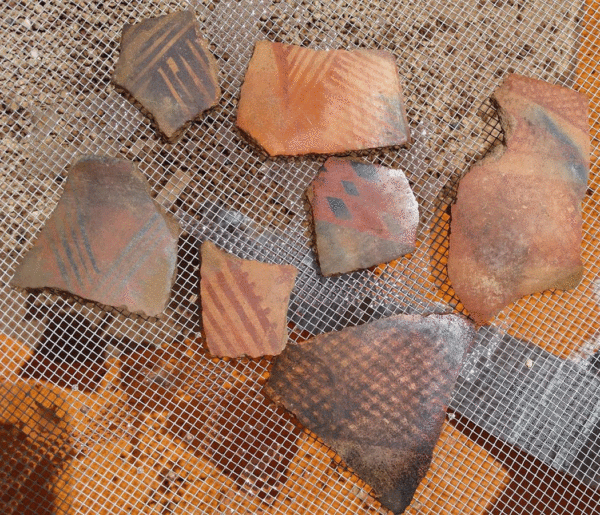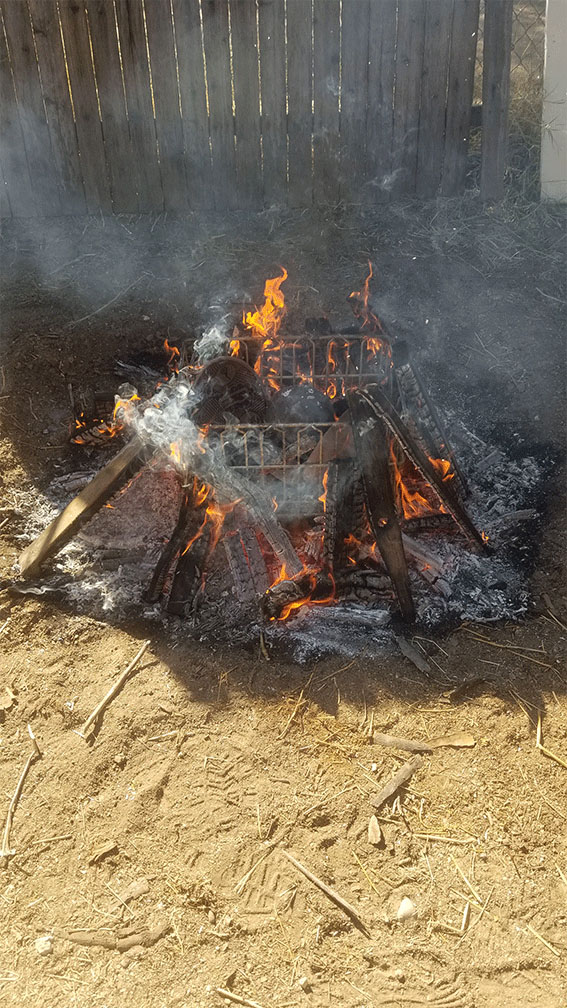
A Ceramic Firing by a Tohono O’odham Potter
Desert Archaeology project director Homer Thiel documents a Tohono O’odham pottery firing session.
Twice in the last year, Tohono O’odham potter Dr. Reuben Naranjo has held pottery firings in the backyard of Desert Archaeology project director Homer Thiel’s house. University of Arizona professor Lisa Molomot’s students filmed the first firing for an upcoming documentary project. The second firing took place in November 2022 and members of the public and Desert staff were invited to attend and participate. Several of the people present teach pottery making and were excited to see how O’odham potters fire vessels. The Desert staff attending were Jim Heidke, Jim Vint, Hunter Claypatch, Leslie Aragon, and Sarah Herr, all of whom have specialized in ceramic analysis.
People have been crafting pots in the Sonoran Desert for several thousand years, collecting clays, tempering material (which helps prevent vessels from cracking during firing), and hematite (red ochre) which was used to paint designs or coat the entire vessel. From about AD 500 to 1450, the Hohokam crafted pots for storage, cooking, and serving foods and beverages, as well as for storing seeds and other items that needed to be protected from water, insects, and rodents. They also placed ceramic vessels in their funerary features. They are well known for the elaborate designs they painted on their bowls and jars. They also made many plain vessels.
Reuben Naranjo has been making pottery for decades, learning the craft from O’odham elders. He begins the process by obtaining clay from various places in Mexico and Arizona, their locations usually a closely guarded secret. Clay from different sources will fire different colors. Naranjo recently found a clay source in the Santa Cruz River bed that is light gray after firing. He always leaves an offering behind after he collects clay; O’odham historically often used pieces of red cloth for this.
Naranjo soaks the clay in water and processes it to remove inclusions such as pebbles. He uses the paddle and anvil technique to make his vessels, forming the vessel base by hand and then gradually building up the sides. He holds a rock against the side and gently beats it with a small wooden paddle. When the vessel is completed he polishes it with a smooth stone. Smaller vessels can be made entirely by hand.
A video of Reuben making a small pinch pot is available on Youtube.
The red ochre pigment that he uses to paint with starts as a rock that he breaks up and then grinds into a powder using a mano and metate. He mixes the ochre with water and paints the designs with a brush. Some of the designs are based on those used by the Hohokam of the Sonoran Desert, while others are his own. After painting the vessels are allowed to dry for a while.
Naranjo began the November firing by digging a shallow pit and positioning four bricks on its bottom for a base. He covered the bottom of the pit with sticks, pieces of wood, and some paper and set a metal crate on top of the bricks.
One of the guests was given the opportunity to light the paper on fire. The flames spread rapidly.
After the first stack of wood burned down to embers, Reuben set the crate on the bricks. The vessels to be fired were then placed in the crate, positioned so that air could circulate.
He then stacked more wood and sticks over the sides and top of the crate, and the flames quickly restarted.
Reuben prefers certain types of wood, especially mesquite and the skeletons of cholla cactus. Other types of wood are avoided. Naranjo does not use pine because the resin can drip onto the vessels and leave stains. He did experiment by using some pinecones in the firing and was surprised at how quickly the caught fire.
The firing was quite dramatic, with the fire burning fiercely and giving off a lot of heat. Additional wood pieces and sticks were added to maintain a steady high heat.
It only takes about 45 minutes to an hour to complete the process. By the end of the firing, most of the wood and sticks had been reduced to ashes and embers. Some of the vessels have fire clouds, where a piece of wood or stick fell onto the vessel and left a scorched area.
The vessels were allowed to cool for a while inside the crate in the pit.
The crate was then removed from the fire and the pottery vessels were allowed to cool more. After a short time each piece was carefully removed and examined. A ringing sound when tapped indicated a successful firing.
Naranjo says that the majority of his pots now survive the firing, a result of years of practice. He said that early on he had many failures, but experimentation has dramatically increased his success rate.
After one of the firings, Dr. Naranjo offered vessels for sale.
Archaeologists have not found Hohokam pottery firing locations. Why is that the case? A couple of explanations are likely. The first is that Hohokam houses and ramadas were made from highly flammable materials. We often find burned structures, sometimes with the possessions of the residents still in place. It is likely that villagers fired their pottery far enough away from their villages to prevent burning down their homes.
In addition, firing takes a large amount of fuel, and the areas close to Hohokam villages were probably stripped of available materials by the people using wood for building their houses, for everyday items (such as wood for tool handles and vessels), and for firewood. Potters would have had to go some distance from the village to find enough flammable materials.
One place with abundant fuel would have been the creek and river beds of the area, which were also far enough away from villages to reduce fire danger. These locations would have flooded in the monsoon season, removing all traces of the event.
What we do find during our archaeological work are piles of clay, tempering material, and lumps of red pigment. We also find polishing stones and rounded stones that may have been used with paddles.














